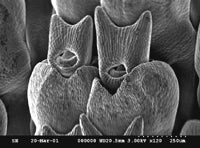This project is funded by the NSF Plant Genome Program.
Inflorescences bear the fruits and grains that we eat, and thus understanding the genetic and regulatory basis for how these structures are formed has clear agronomic importance. Inflorescence architecture among cereal crops is diverse, yet characterized by a unique morphology, where flowers are borne on short, determinate branches called spikelets. Variations in inflorescence branching patterns arise from position and developmental fate of differentiating stem cell populations called meristems. The coordinated actions of key developmental regulators, as well as genetic interactions between them, modulate meristem initiation and determinacy during maize inflorescence development. Our goal is to understand the mechanisms by which these regulators act to control inflorescence architecture, what other factors and/or biological processes are involved in this regulation, and how these regulatory networks coordinate development in space and time. Findings from this work can be translated to other important cereal crops with comparable inflorescence architectures.
Our approach integrates large-scale genomics datasets, such as gene expression profiles achieved by high-throughput RNA-sequencing, with discrete morphological features in development. Here, we characterized precise timing of developmental transitions at the molecular level in maize male and female inflorescences, tassel and ear, respectively, by associating spatiotemporal dynamics in gene expression with morphological changes resulting from genetic perturbations in a pathway controlling branching. The latter includes loss-of-function mutants in three important regulators of the ramosa (ra) pathway, which controls stem cell fate and the decision to branch.
To expand our co-expression network and gain insight into the mechanisms of gene regulation in the ramosa pathway, we identified in vivo gene targets of the RA1 transcription factor (TF) using Chromatin Immuno-Precipitation followed by high-throughput sequencing (ChIP-seq). We used ra1 mutant maize lines expressing RA1 tagged with either HA or YFP to identify ~1,000 high-confidence target genes . Of these, ~1/4 showed altered expression in the ra1 background, suggesting that they are modulated targets. Strikingly, activated and repressed targets are exclusively co-expressed, respectively, suggesting that the mechanism of RA1 action is dependent on spatiotemporal context. Targets shared between RA1 and KN1 networks were enriched for TFs and suggest points of regulation that interface meristem maintenance and determinacy.

